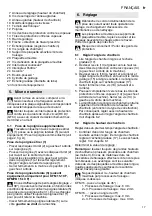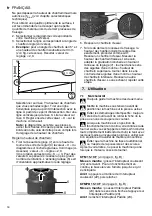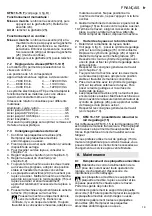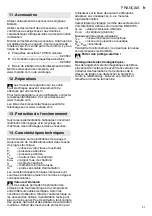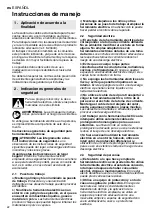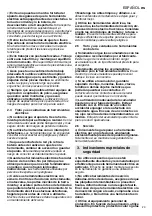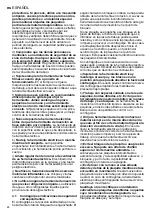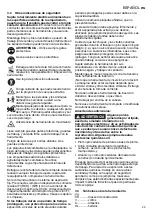
ENGLISH
en
10
KFM 15-10 F
(see page 3, Fig. B):
Switching on:
push the sliding switch (22)
forwards. For continuous operation, now tilt it
downwards until it engages.
Switching off:
press the rear end of the slide switch
(22) and release it.
KFMPB 15-10 F
(see page 3, Fig. B):
Switching on:
slide the paddle switch (23) in the
direction of the arrow and then press the
Switching off:
release the paddle switch (23).
KFM 16-15 F
(see page 3, Fig. B):
Torque activation:
Switching on:
press in the lock (24) and then press
the trigger switch (25). Release the lock (24).
Switching off:
release the trigger switch (25).
Continuous operation:
Switching on:
press in the lock (24) and hold it in
place. Press and hold in the trigger switch
(25). The machine is now switched on. Now
press in the lock (24) once more to lock the
trigger (25) (continuous operation).
Switching off:
press the trigger switch (25) and
release.
7.2 Setting speed (KFM 15-10 F)
The speed can be preset via the speed adjustment
wheel (10) and is infinitely variable.
Positions 1-6 correspond approximately to the
following no-load speeds:
1 ........ 7800 / min
4....... 10200 / min
2 ........ 8600 / min
5....... 11100 / min
3 ........ 9400 / min
6....... 12200 / min
The VTC electronics make material-compatible
work possible and an almost constant speed, even
under load.
Speed recommendations for different materials:
Aluminium, copper, brass.............................. 4-6
Steel up to 58.015 psi ................................... 4-6
Steel up to 87.022 psi ................................... 3-5
Steel up to 130.534 psi ................................. 2-4
Stainless steel ............................................... 1-3
The best way to determine the ideal setting is
through a practical trial.
7.3 General working instructions
1. Check the indexable inserts (20). Change
damaged or worn indexable inserts.
2. Fix workpiece without vibrations using clamping
devices.
3. Pay attention to chapter 7.4 when working on
pipes.
4. Set the chamfer angle (see chapter 6.1).
5. Set the chamfer height (see chapter 6.2).
6. Always hold the machine with both hands on the
designated handles, take a secure stance and
concentrate on the work.
7. The indexable inserts (20) do not touch the
workpiece. First switch on, then place the
machine with the guide rail (15) onto the
workpiece and only then put the tool close to the
workpiece.
8. Slide the machine only in the direction specified
by an arrow on the machine (16).
Slide the machine only in the direction of
the arrow (16). Otherwise there is the risk
of kickback. Guide the machine evenly at a
speed suitable for the material being processed.
Do not tilt, apply excessive force or sway from
side to side.
9. Guide the machine in such a way that the guide
rail (15) is in contact with the workpiece.
10.Finishing the work: remove the tool from the
workpiece, switch off machine. Let motor come
to a stop, put down machine.
7.4 Working on the outer edge of pipes
1. Determine the diameter of the pipe to be worked
on.
2. See page 3, Fig. C: attach the guide roller (26) to
the guide rail (15) as shown. Move the guide
roller (26) and adjust on the scale (27) on the
pipe diameter. Tighten the guide roller nut with a
spanner and thus tighten the guide roller.
3. Pay attention to the general working instructions
(chapter 7.3).
4. Always hold the machine with both hands on the
designated handles, take a secure stance and
concentrate on the work.
5. Place the machine with the guide roller (26) on
the outer surface of the pipe. Then place the
guide rail on the surface of the pipe end.
6. The indexable inserts (20) do not yet touch the
workpiece. First switch on, then slowly tilt the
machine around the guide roller (26) to move the
milling head close to the workpiece.
7. Pay attention to the general working instructions
(chapter 7.3).
7.5 KFM 16-15 F: Possibility for rotating the
guide rail (15)
The guide rail (15) of the KFM 16-15 is installed
transversely. This permits better absorption of high
forces and permits low-fatigue working for most
tasks.
If you prefer to install the guide rail (15) in a
longitudinal manner, the Metabo customer service
will provide you with conversion instructions on
request.
8.1 Changing indexable inserts
Pull the plug out of the socket before making
any adjustments, changing tools, carrying out
maintenance or cleaning.
Indexable inserts, holders for indexable
inserts, the workpiece and chips can be hot
after work. Wear protective gloves.
8. Maintenance

















